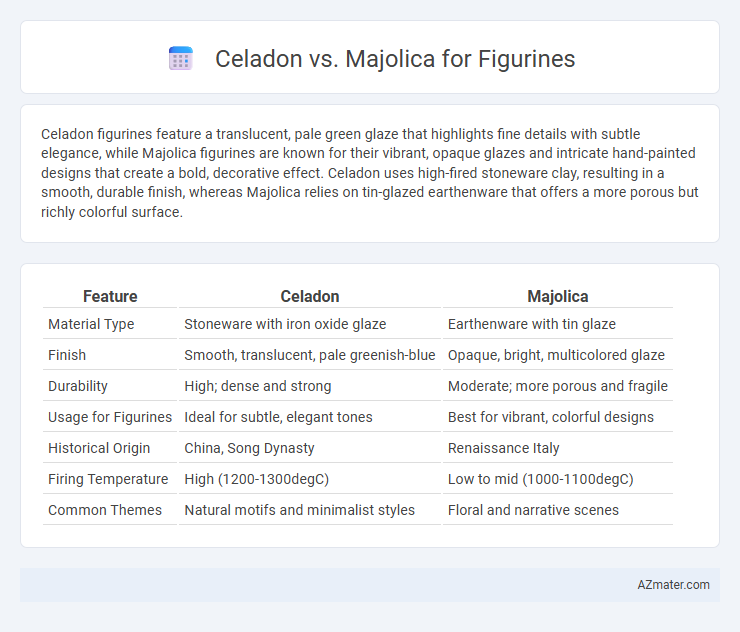Celadon figurines feature a translucent, pale green glaze that highlights fine details with subtle elegance, while Majolica figurines are known for their vibrant, opaque glazes and intricate hand-painted designs that create a bold, decorative effect. Celadon uses high-fired stoneware clay, resulting in a smooth, durable finish, whereas Majolica relies on tin-glazed earthenware that offers a more porous but richly colorful surface.
Table of Comparison
| Feature | Celadon | Majolica |
|---|---|---|
| Material Type | Stoneware with iron oxide glaze | Earthenware with tin glaze |
| Finish | Smooth, translucent, pale greenish-blue | Opaque, bright, multicolored glaze |
| Durability | High; dense and strong | Moderate; more porous and fragile |
| Usage for Figurines | Ideal for subtle, elegant tones | Best for vibrant, colorful designs |
| Historical Origin | China, Song Dynasty | Renaissance Italy |
| Firing Temperature | High (1200-1300degC) | Low to mid (1000-1100degC) |
| Common Themes | Natural motifs and minimalist styles | Floral and narrative scenes |
Introduction to Celadon and Majolica Figurines
Celadon figurines are renowned for their translucent, pale green glaze that originates from ancient Chinese pottery techniques, emphasizing smooth finishes and subtle elegance. Majolica figurines feature vibrant, colorful glazes derived from tin-glazed pottery traditions of the Italian Renaissance, celebrated for their intricate, detailed patterns and lively hues. Both styles demonstrate unique historical craftsmanship, with celadon highlighting serene minimalism and majolica showcasing ornamental richness in ceramic art.
Historical Origins of Celadon and Majolica
Celadon originated in ancient China during the Eastern Han Dynasty, known for its jade-like green glaze achieved through iron oxide firing techniques. Majolica has roots in the Italian Renaissance, characterized by its tin-glazed earthenware decorated with vibrant, opaque colors. These distinct historical origins highlight Celadon's subtle elegance and Majolica's bold decorative style in figurine artistry.
Material Composition and Techniques
Celadon figurines are crafted using a stoneware base coated with a translucent, pale green glaze rich in iron oxide, fired at high temperatures to achieve a smooth, glass-like finish. Majolica figurines utilize a porous earthenware body, covered with a tin-oxide glaze that creates a bright white, opaque surface, then hand-painted with vibrant, colored mineral oxides before low-temperature firing. The key difference lies in celadon's subtle, glazed translucency from reduction firing and majolica's vivid, opaque surface achieved through tin glazing and overglaze decoration.
Color Palette and Aesthetic Features
Celadon figurines showcase a subtle, translucent green glaze that enhances fine details with a smooth, matte finish, delivering an elegant and serene aesthetic. Majolica figurines boast vibrant, multicolored glazes with intricate, hand-painted designs, characterized by glossy textures and bold, decorative patterns. The contrasting color palettes position Celadon as minimalist and refined, while Majolica exudes a lively, ornamental appeal.
Durability and Longevity Comparison
Celadon figurines are known for their durability due to their high-fired stoneware composition, which makes them resistant to chipping and cracking over time. Majolica figurines, made from earthenware and coated with a tin glaze, are more prone to surface wear and glazing imperfections, affecting their longevity. For collectors prioritizing long-term preservation, celadon offers superior structural integrity and sustained aesthetic quality compared to the more fragile majolica.
Artistic Styles and Design Motifs
Celadon figurines are distinguished by their smooth, translucent glaze in soft green hues, often featuring simple, nature-inspired motifs such as leaves and flowers, emphasizing subtle elegance and harmony. Majolica figurines showcase vibrant, multicolored glazes with intricate, raised patterns depicting folk art themes, animals, or biblical scenes, highlighting bold artistry and decorative richness. Both styles embody distinctive artistic traditions, with celadon stressing minimalism and majolica emphasizing vivid, textured detail.
Value and Collectibility in the Art Market
Celadon figurines, prized for their translucent jade-green glaze and historical significance, often command higher value due to their rarity and association with ancient East Asian ceramics. Majolica figurines, known for their vibrant, tin-glazed earthenware and intricate, colorful designs, attract collectors interested in 19th-century European decorative arts but generally hold moderate market value compared to celadon. The collectibility of celadon benefits from its cultural heritage and limited production, while majolica's appeal lies in its decorative versatility and accessibility in the art market.
Popular Uses in Figurine Crafting
Celadon glaze is prized in figurine crafting for its translucent, jade-like finish that enhances intricate details and gives a smooth, elegant appearance, commonly used in East Asian-inspired sculptures. Majolica is favored for its vibrant, opaque colors and glossy surface, making it ideal for decorative figurines with bold, artistic expressions and folk motifs. Both glazes are popular for their unique aesthetic qualities, with celadon emphasizing subtlety and majolica focusing on vivid color contrast in figurine art.
Care and Maintenance for Celadon vs Majolica
Celadon figurines require gentle handling and regular dusting with a soft cloth to maintain their translucent glaze and prevent surface scratches, while avoiding harsh chemicals that can dull their subtle green hues. Majolica figurines demand careful cleaning with a mild soap solution and a soft brush to preserve their vibrant, colorful glazes and intricate relief patterns, as abrasive materials can damage the tin-glaze finish. Proper humidity control is essential for both Celadon and Majolica to prevent cracking, with Celadon benefiting from stable, moderate humidity and Majolica requiring extra caution to avoid moisture absorption that can weaken the ceramic body.
Choosing the Best for Your Figurine Collection
Celadon offers a smooth, translucent glaze known for its subtle green hues and durability, making it ideal for collectors seeking elegance and longevity in figurines. Majolica features vibrant, hand-painted designs with a textured glaze that adds a colorful and artistic touch, perfect for those who prioritize decorative appeal and uniqueness. Choosing between celadon and majolica depends on preferences for classic simplicity versus vivid ornamentation in your figurine collection.

Infographic: Celadon vs Majolica for Figurine
 azmater.com
azmater.com